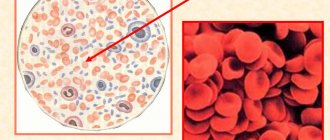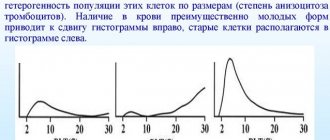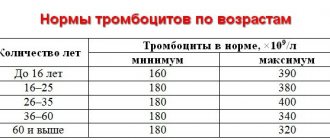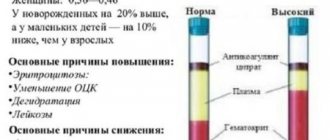Treatment
Hospitalization of the baby is necessary only in the most extreme cases. If the cause is not oncology, treatment is carried out using conservative methods:
- nutrition correction;
- taking medications;
- compliance with the daily routine.
The medicinal part of treatment may include drugs with the following spectrum of action:
- for blood thinning;
- to reduce platelet production;
- non-steroidal anti-inflammatory drugs;
- vitamin and mineral complexes.
Be sure to exclude from your diet foods that produce this blood component. You should add foods that are rich in vitamin B6 and magnesium to your menu. It is necessary to monitor the drinking regime - the child should be given clean water, herbal decoctions, juices and compotes.
Decoding
Many people ask what PDW is in a blood test and who interprets the test. The doctor must decipher the PDW blood test. PDW may be normal, elevated, or decreased. A normal index occurs when the number of old and young cells is the same. This index occurs in healthy people. If the indicator is elevated, then their number has sharply increased, and a large number of young and old cells are contained. This happens with bone marrow pathologies or other diseases.
An increased value of the indicator is determined in cancer, iron deficiency, and inflammatory processes. This result occurs with infectious diseases or when the patient uses hormonal drugs. A decreased PDW indicates that there are more old particles, which may indicate bone marrow disease, viral diseases, or certain medications.
When doctors decipher the result, sometimes the study shows that a person has too large platelets, which indicates the presence of disturbances in the functioning of the immune system or Bernard-Soulier disease.
Norm
The normal PDW in adults is 15-17%. The breadth of platelet population distribution in children under 18 years of age is 10-15%. If there is a deviation from the norm, the doctor considers the possibility of dysfunction of organs or systems. This indicates some kind of disease.
Increased level
An increase in the indicator indicates heterogeneity in platelet volume. This can cause the development of pathologies in the body. In patients, blood vessels gradually become clogged, blood circulation is disrupted, and metabolism slows down. Heart disease gradually develops.
An increase in PDW occurs:
- For anemia. The process causes oxygen starvation, which contributes to a change in cell volume.
- For bleeding after surgery.
- With the development of neoplasms and inflammatory processes.
- If, in addition to an increase in PDW, an increased number of leukocytes is noted, then the doctor diagnoses inflammation.
The role and significance of PDW for the body
PDW is an indicator of the heterogeneity of platelets, an important component of human blood.
If there are not enough blood platelets, when a blood vessel is damaged, large blood loss occurs: there is not the necessary volume of cells that can stop the bleeding. If there is an excess of platelets, a blood clot is formed, which can break away from the site of formation, block the lumen of the vessel, provoke tissue necrosis, and in some cases, death.
This is why the PDW indicator is extremely important: without it, it is impossible to determine whether the level of platelets in the bloodstream is high or low. Blood platelets, which are synthesized in the bone marrow, in addition to stopping bleeding, have other functions in the body: the cells stop inflammation, participate in the regeneration of damaged blood vessels, and filter antigens. Platelets live no more than 10 days; there are both young and old cells in the blood. The platelet distribution index (PDW) shows the percentage of old and new platelets.
Normally, there should be a dynamic balance of different platelet variants with a predominance of young forms.
Distribution width is higher than normal
The indicator is highly lable, so the slightest pathology of the body changes the percentage of PDW.
The main reasons for increased platelet indices are:
- Any type of inflammation. This cause can be suspected if, in addition to increased heterogeneity, there is a high ESR and leukocytosis (signs of inflammation).
- Anemia. An increase in the indicator should be associated with a decrease in hemoglobin and the number of red blood cells.
- Malignant formations. It is assumed that the index increases when the metastasis process is activated. Platelets help with this through thromboembolism. They spread cancer cells.
- Blood loss (operative, traumatic, menstrual). The bone marrow actively produces cells and many young forms appear.
- Thrombocytopathies, thrombocytopenia associated with impaired immunity.
- Other causes include heavy exercise, sports, overeating, pregnancy and medications. Therefore, if the doctor sees a deviation from the PDW norm, but other indicators are normal, then there is no need to sound the alarm. It can be changed for a trivial reason. Over time, the numbers return to normal.
How is the analysis carried out?
The PDW value is determined during a general blood test along with many other indicators. Blood is taken from the (ring) finger on an empty stomach in the morning. Whole blood with an anticoagulant is used for the study.
The result may be unreliable if the patient ate food before the analysis, is being treated with medications during this period of time, or underwent an X-ray examination or physical procedures the day before. In addition, the indicator may be higher or lower than normal during pregnancy, before menstruation, or after heavy mental or physical stress. In such cases, a repeat study is prescribed. To avoid distortion of the results, you should properly prepare for the analysis.
Nowadays, modern hematological analyzers are used for blood testing, which obtain up to 24 indicators. Determining platelet volume alone is not sufficient for effective diagnosis. Normal hemostasis depends not only on the quantitative content of nuclear-free plates, but also on their functional indicators
Therefore, it is so important to study their quality characteristics, which is only possible on new equipment. Hardware methods for studying blood elements have many advantages over manual ones:
- a large number of cells are examined - from 10,000;
- provide accurate results - without errors;
- all stages of the study are standardized.
Using modern blood analyzers, histograms are obtained - a graphical representation of the results in the form of thrombocytometric curves
The importance of this study is due to the fact that the size of platelets determines their functionality, the change in their volume before gluing the plates in the process of clot formation, as well as the tendency to adhesion and the content of bioactive substances in anucleated cells
If there are predominantly young platelets in the blood, the histogram is shifted to the right, old platelets are located on the left of the graph. Thus, platelet volume decreases as platelet aging occurs.
What is PDW in blood test?
Currently, more than twenty indicators are known that help the doctor make accurate conclusions about the patient’s health status.
Among these, the platelet index PDW is a blood test, the decoding of which sounds like “the width of the distribution of platelets by their volume.” It characterizes the heterogeneity of various cells, including changes in their sizes. In other words, blood cells have different sizes, and it is the number of macro- and microplatelets that confirms this blood test. Decoding PDW helps to identify many serious pathologies in the body. Blood for analysis should be taken from a finger on an empty stomach. Whole blood is placed in a test tube into which an anticoagulant is added in advance. Currently, the study is carried out on analyzers, which in addition to this indicator can give 24 more. It is very important to correctly pass a clinical blood test. Decoding PDW depends on taking into account many circumstances, such as food intake, overload, pregnancy, day of the menstrual cycle. Therefore, you should donate blood on an empty stomach, avoid stress, heavy physical labor, and do not conduct research during menstruation.
There is also such a thing as taking into account the SD index on a PDW blood test. Decoding PDW-SD, an indicator characterizing platelet heterogeneity, brings the result closer to ideal accuracy. SD in this case is the standard deviation. It is taken into account when calculating the index.
What to do if the platelet distribution index is elevated
Platelets are the most microscopic blood cells that can stick together to form a blood clot. It is needed in cases where the integrity of a capillary, vein or artery is damaged. Thanks to platelets, damaged vessel walls are sealed from the inside, which prevents the development of full-scale bleeding.
One of the indicators of laboratory tests for platelet count is the PDW index. Thanks to this analysis, the width of platelet distribution is determined - an important indicator by which one can judge the presence of many diseases and pathologies. What standards have been established, and what standards are recognized, as well as the reasons and consequences of increasing the maximum permissible values, we will analyze further.
In a healthy person, the normal width of platelet distribution by volume is 15-17 percent. Deviations of 2-3 percent are acceptable, which are attributed to the following manifestations:
- the blood test was taken incorrectly (on a full stomach, in the presence of drug impurities);
- physical and moral condition of the patient;
- the presence of chronic inflammatory diseases.
For children, the norms are slightly different: under the age of 18, rates from 10 to 16 percent are acceptable, writing off 1% in each direction. Poor immunity and increased vulnerability of the body, as well as the presence of congenital pathologies, make this indicator less reliable when deciphering a blood test.
Based on the fact that the reliability of platelet distribution width indicators is influenced by the general condition of the body, in the presence of chronic diseases, noma indicators may vary.
It is necessary to prepare for the test in advance
Indications for analysis
There are four cases when a complete blood count and identification of the PDW indicator is mandatory:
Feel free to ask your questions to a staff hematologist directly on the website in the comments. We will definitely answer.Ask a question>>
- When hospitalized, it is included in the mandatory list of tests required for the initial medical history.
- To monitor treatment, a blood test to determine the width of platelet distribution allows you to see the effect of treatment, or, on the contrary, to find out about its absence and the need to prescribe new drugs.
- An annual medical examination is a mandatory procedure not only for workers in all professions and industries, but also for children of all ages.
- In the presence of diseases of the circulatory system and suspected blood cancer, as well as for diagnosing inflammatory diseases.
A blood test is mandatory in most cases. It can be used to tell about a person’s health status, indicating possible problems.
In qualified clinics that have their own laboratories with ultra-precise equipment, the patient is given a transcript in hand, which is a table consisting of several columns. It reflects the available indicators, their norm and presence in human blood.
Usually the last column indicates whether there are deviations from the norm and what could cause this.
Deviation from the norm indicates the presence of pathologies or diseases, the treatment of which should be started as quickly as possible. A pathological condition is considered to be not only a result above the norm, but also a value below the recommended values. The therapist who receives the results of the analysis is obliged to inform the patient about possible problems with his health, as well as compare the patient’s symptoms and complaints with the data received. After this, a decision is made to undergo a comprehensive examination, the results of which will ultimately make it possible to make the correct diagnosis and select the most successful and effective treatment.
preparation for analysis was not carried out
- physical overload;
- unstable emotional background, especially in depressive states;
- eating immediately before blood sampling;
- During pregnancy and breastfeeding;
- blood sampling during menstruation in women;
- presence of chronic diseases;
- taking medications.
Therefore, in order to obtain the most accurate data, you should be in a good mood, not experience physical overload, and also limit your food intake. Women during menstruation or in the premenstrual period are better off refraining from testing. Taking blood without fasting and the presence of menstruation are the two most significant and significant factors on which the accuracy of the analysis depends.
It is important to note that failure to follow the blood sampling rules can also lead to unreliable data on other blood parameters. From here you can get not only deviations from the norm, but also an incorrect diagnosis
What is pdw and its significance for the body
The PDW level in the resulting blood test is an important diagnostic indicator that shows the characteristics of the distribution of blood cells and platelets.
These are the smallest cells that, when bleeding, group together, form a clot and close the wound. They block ruptures in the walls of blood vessels inside the body, avoiding dangerous complications. The abbreviation PDW translated into Russian means “platelet distribution across blood volume.” The cells help the body avoid internal bleeding. But for excellent health, the balance of blood cells is important: a deficiency threatens death in case of injury or fracture, an excess leads to the formation of blood clots that block blood flow in the muscles, brain and spinal cord.
When thrombocrit is low
A decrease in PCT occurs when the production of platelets or platelet precursors, which are megakaryocytes, is blocked. With a decreased PCT, there is a tendency to bleed.
This indicator is reduced during pregnancy. The drop in thrombocrit in women can be 2 times lower than normal, but during pregnancy this reduces the risk of thrombosis, and means that blood circulation and fetal nutrition will not be affected.
PCT decreases in conditions caused by:
- anemia - folate deficiency, aplastic, megaloblastic;
- autoimmune diseases – systemic lupus erythematosus, collagenosis;
- chronic diseases of the liver, kidneys;
- poisoning by poisons, drugs - diuretics, cytostatics, antibiotics, corticosteroids;
- chemotherapy;
- oncological diseases - hemoblastosis, leukemia.
When the thrombocrit is lowered and is less than 0.11%, then in adults this indicates a disorder of hematopoiesis in the bone marrow or an acceleration of the breakdown of platelets in the spleen.
A low PCT thrombocrit in a child’s blood test may be explained by:
- in infants - prematurity, low birth weight, hypoxia;
- in a child of an older age group – parasitic infection.
PDW: blood test (decoding). Reduced level
For many pathologies, determining not only an increase, but also a decrease in PDW levels helps to make a correct diagnosis and prescribe adequate treatment. This index is lowered when:
- leukemia;
- radiation sickness;
- myelodysplastic syndrome;
- DIC syndrome;
- viral diseases;
- sepsis;
- use of cytostatics;
- megaloblastic anemia;
- cirrhosis, chronic hepatitis.
Nowadays, it is important to have general concepts about many things. But it is even more important to evaluate your knowledge adequately. Having ideas and deep knowledge are not the same thing. Therefore, you need to understand that PDW is a blood test, the interpretation, norm and meaning of which are well known only to a specialist. The person himself should not draw any serious conclusions about the studies and their indicators; he needs to go to a medical institution.
A general blood test is the most common among various examinations in medicine. In addition, it is the simplest and quite effective, since the results show quite a lot of different components directly in the human blood. One of these components is the PDW indicator. How to understand the interpretation of the analysis, what does the relative width of platelet distribution by volume mean, and why can the index be increased?
Many years ago, doctors discovered the fact that human blood contains many different enzymes, different cells and other substances. Everything together forms one unified system, focused directly on the normal functioning of the circulatory system and the body in general. In addition, it is worth noting that for normal functioning of our body there must be a certain norm of all components. The same applies to the PDW indicator in a blood test; if it is elevated, then appropriate measures must be taken.
When PDW Becomes Important
The decoding of the analysis proceeds in parallel with the decoding of other platelet indices (primarily MPV).
This platelet indicator is increased in the case of certain pathological conditions:
- Inflammatory processes;
- Liver pathologies;
- Cardiovascular diseases;
- After removal of the spleen;
- Malignant neoplasms and, in particular, their metastasis to the bone marrow;
- Massive blood loss;
- Poisoning with salts of heavy metals (lead);
- Certain anemic syndromes;
- Corticosteroid therapy;
- Alzheimer's diseases.
In addition, the index is also increased in some cases that can hardly be called pathological conditions, but which could cause a high degree of platelet anisocytosis:
- Excessive physical activity;
- Surgery.
The platelet index PDW, on the contrary, is reduced when:
- Some blood diseases;
- Radiation sickness;
- Myelodysplastic syndrome;
- Megaloblastic anemia;
- DIC syndrome;
- Diseases of viral origin;
- Septic conditions;
- Severe liver damage.
In addition, PDW is reduced in situations where there is a need to use certain groups of pharmaceuticals, for example, cytostatics.
examples of PDW graphs – normal, with thrombocytopenia, hyperthrombocytosis with the presence of macroplatelets in the blood
Taking into account that platelets are sensitive cells, when going for analysis, you need to remember some rules: do not overeat, do not overload mentally, do not overexert yourself physically, do not smoke or drink medications that can change your blood picture. However, given that such a test is not carried out independently, but goes in tandem with other platelet indices, there is no point in describing the entire preparatory part in detail
The reader can find answers to these questions in other publications concerning the general blood test in general and the platelet component in particular.
Display all posts with the tag:
Analyzes
Go to section:
Blood diseases, tests, lymphatic system
Recommendations to SosudInfo readers are given by professional doctors with higher education and specialized work experience.
One of the leading authors of the site will answer your question.
PDW is below normal
Low platelet level
If the platelet volume distribution index is low, there may not be any pathologies. However, in some cases, even the slightest decrease in the platelet index can lead to death. The most common reasons why PDW in a blood test is low:
- Leukemia. Another name for this disease is blood cancer. Clonogenic stem cells attack the bone marrow and interfere with normal blood cell secretion. As a result, the patient’s blood test showed lower levels of all indicators.
- Chronic hepatitis B. The disease is “mild” with timely drug therapy.
- Thrombocytopenia. The PDW is low due to blood loss or anemia.
- Radiation sickness. Radioactive radiation can significantly affect the function and number of lamellar cells in the blood. The most typical symptoms of this disease are: hypotension, limb tremors, muscle atony and diarrhea.
- Myelodysplastic syndrome. The disease affects the bone marrow and disrupts the synthesis of blood cells.
Features of the analysis
It is necessary to prepare for the test in advance
Which doctor should I contact?
Causes of high and low PDW levels
An elevated platelet count is a reason for an in-depth examination of the patient. The heterogeneity of blood cells negatively affects the composition of the blood and provokes its thickening. More clots form, blocking the access of nutrients and oxygen to the capillaries.
Possible reasons why pdw is elevated include:
- The body intensively produces cells after blood loss during injury or surgery.
- Chronic anemia and oxygen starvation of the body.
- Oncological diseases.
- Hidden inflammatory processes.
In some cases, the reason for the high rate is improper preparation of the patient for testing. It can change if you have a heavy snack before going to the laboratory, so donate blood only on an empty stomach.
The pdw level in the analysis is reduced for the following reasons:
- Myeloplastic syndrome with damage to human bone marrow.
- Chronic form of hepatitis with high concentration of bilirubin.
- Lack of B vitamins.
Sometimes a reduced level occurs during a long-term strict diet or fasting. The cause is intestinal disease, in which nutrients are poorly absorbed into the blood.
Increase in coefficient
If the PDW decoding indicates an increase in values, this is a direct sign of significant heterogeneity of the described cells in volume. And, accordingly, this state of the blood fluid can lead to dangerous consequences. The gradual clogging of capillaries, and then larger vessels, causes difficulties with blood circulation, which leads to even greater thrombus formation. This results in a so-called vicious circle.
PLT in blood test - what is it?
The result of this condition can be many pathologies, ranging from metabolic disorders in the bloodstream to heart disease (myocardial infarction) or blood clots in the brain (stroke).
Indicators may be elevated in the following situations:
- Bleeding due to surgery or injury leads to an increase in platelet concentration, which is due to their increased production. This is required to quickly restore the normal blood formula.
- Anemia, which causes oxygen starvation, as a result of which nuclear-free blood cells undergo various types of deformation.
- Pathologies of an oncological nature, leading to systematic damage to all formed elements of the blood, including platelets. This, in turn, causes a change in their volume, and, consequently, the width of distribution in the blood mass itself.
- Inflammatory processes leading to an increase in the number of these cells, and as a result, an increase in PDW. A parallel increase in leukocytes can only mean one thing – the development of inflammation is obvious!
At the same time, you should know that if PDW is elevated, then not in all absolutely cases this will mean the presence of any serious abnormalities in the body. The reasons for this can be the most trivial, for example, failure to comply with the basic rules of preparing for a blood test or directly collecting it from the laboratory medical staff.
Therefore, before undergoing the analysis, it is necessary to consult with a doctor about all possible subtleties in order to minimize the risks of receiving unreliable results and repeated analysis. Firstly, you need to know that blood is donated only on an empty stomach, that is, at least 10–12 hours must pass between the last meal and the collection of biomaterial.
Secondly, it is necessary to exclude excessive physical activity and, if possible, psycho-emotional activity the day before the study. Thirdly, you should refrain from taking any medications, even if they are multivitamin complexes, having previously discussed stopping them for several days. Strict adherence to all of the above measures will allow the doctor to see a complete picture of the patient’s blood condition.
Treatment and prevention
Before starting treatment, it is necessary to determine what is causing the increased platelet distribution. The therapeutic technique is selected depending on the reason for the increase in the index:
- Inflammatory diseases. In this case, antibacterial and anti-inflammatory drugs are prescribed to help normalize the condition of the body, including the functioning of the hematopoietic system.
- Oncological diseases. Bone marrow dysfunction is restored by transplantation of donor material, administration of chemotherapeutic agents and radiation.
- Blood loss. The course of treatment includes blood transfusions and the administration of drugs that help raise hemoglobin levels.
Important information: What is erythrocytosis (secondary - primary - absolute)
Prevention of increased platelet distribution in adults and children involves the following measures:
- proper nutrition (the diet should include a sufficient amount of vitamins and nutrients);
- avoiding excessive physical activity;
- refusal of uncontrolled use of medicines;
- compliance with the drinking regime (you need to consume at least 2 liters of water per day);
- exclusion from the diet of confectionery and carbonated drinks.
The value of platelet distribution width is relative. Its increase does not always indicate the presence of diseases, but if such a result is obtained, you need to undergo an examination.
Definition and concept of platelet volume
To make a correct and comprehensive diagnosis, it is not enough to see the platelet count alone. It is necessary to know their average volume. The value indicating the average platelet volume in the blood is called MPV in tests. It is calculated using special equipment and measured in femtoliters (Fl). The device first calculates the platelets themselves in the blood taken, and then calculates their volume (roughly speaking, the space occupied by platelets).
We recommend studying the article “What role do platelets play in human blood?” on a similar topic within this material
Formation of a blood clot from red blood cells and platelets (micrograph layout)
Average platelet volume is reduced
A decrease in average platelet volume occurs when many old, low-volume, “spent” cells circulate and accumulate in the blood. It is logical that a decrease in platelet volume, i.e. qualitative indicator occurs when the quantitative indicator increases.
The average platelet volume is reduced in the following cases:
- diseases of the blood coagulation system (coagulopathy);
- inability to adequately and timely synthesize new blood cells due to oncohematological diseases, congenital bone marrow aplasia, radiation therapy or the use of antitumor drugs that inhibit hematopoietic function;
- inability to fully utilize “waste” cells (diseases of the liver and spleen, lymphogranulomatosis).
We also recommend studying this topic:
Average platelet volume is increased
An increase in the average volume occurs when young (up to blasts) elements of the platelet series are present in the blood. Immature platelets are released into the bloodstream due to increased bone marrow activity.
Hematology analyzer
The mean platelet volume is increased when:
- post-hemorrhagic conditions (anemia, blood loss - acute and chronic);
- congenital diseases (thrombocytopenic purpura of Henoch-Schönlein, thalassemia);
- diabetes mellitus;
- infectious diseases.
Carrying out analysis
The indicator is determined by drawing blood. In order for the indicators to correspond to reality, the following must be taken into account:
- It is not recommended to take the test during the premenstrual period.
- The day before donating blood, you should avoid heavy physical activity and, if possible, avoid taking medications.
- Tests must be taken on an empty stomach; in the morning you can only drink a glass of water.
The determination of indicators is carried out using the Fonio method. The material for the study is blood obtained from a finger, mixed with a sterile solution of magnesium sulfate.
From the resulting material, a smear is made on glass, which is placed in special equipment. The automatic counter counts the number of different forms of platelets per 1000 red blood cells. Using a special formula, the percentage of the width of the distribution of blood platelets is calculated.
Reasons for the decline
A decrease in the number of platelets in a blood test indicates a high risk of bleeding due to low blood clotting. This must be taken into account in surgical operations.
A reduced PDW in a blood test occurs with myelodysplastic syndrome. This disease affects the bone marrow, where platelets are formed. Hepatitis provokes a decrease in PDW. In this case, the analysis will show increased bilirubin. Possible cancer.
An increased distribution of platelets in a child may be due to an inflammatory process. Also, the number of leukocytes in this case will be high.
Why deviation is dangerous and what to do
If the test result shows that the PDW does not meet the norm, the therapist will order you to take it again in different laboratories. If this is confirmed, then a comprehensive examination is prescribed. If the patient has additional symptoms, it is easier to make a diagnosis.
A reliable result is not only due to the patient’s good preparation, but also to the laboratory in which the blood is drawn. Poor quality reagents incorrectly determine blood composition. It is advisable to take tests in laboratories that have quality certificates and modern equipment.
Only a specialist should explain the result: there are many nuances in deciphering the PDW indicator. In some cases, the indicator is looked at in relation to other points of laboratory research.
Reasons for the increase
If the blood test results for PDW are elevated, we may be talking about the presence of the following diseases:
- Oncological pathologies. In the presence of malignant tumors, there is an increased production of platelets that have different sizes and properties. Platelet platelets contribute to the development of cancer by helping cancer cells spread through the body and become metastases.
- Severe blood loss. With a lack of blood, the bone marrow begins to function intensively, producing new blood elements, including platelets. Before cell gluing, the distribution width increases sharply, causing the analysis result to deviate greatly from the norm.
- Chronic inflammatory processes. Along with the production of leukocytes, platelet maturation increases. Some cells are larger in size and have a longer lifespan. This affects the PDW index, which can be many times higher than the established standards.
Other reasons leading to changes in analysis results include:
- anemia of various origins (the width of platelet distribution increases in response to a decrease in hemoglobin levels);
- pregnancy and lactation;
- recovery after complex surgery;
- helminthic infestations (a change in the test result means the body is highly sensitive to substances secreted by parasites);
- heavy menstruation, accompanied by severe blood loss;
- psycho-emotional overload;
- eating before the test;
- use of certain medications;
- increased activity of the thyroid gland and adrenal glands.
Reasons for RDW deviation
If the width of the distribution of red blood cells in the body is increased, this means that the sizes of the red blood cells are very different from each other. Moreover, the larger the red blood cell, the shorter its lifespan, which reduces the number of red blood cells in the body.
With significant destruction of red blood cells, an increased iron content is observed in the blood. At the same time, an increase in bilirubin occurs (the so-called very toxic substance that is formed from dead red blood cells). It is sent to the liver for neutralization, which causes it to become overloaded and poorly cope with processing toxins. This negatively affects the functioning of the entire body.
An increased RDW value in many cases indicates iron deficiency anemia. With this disease, the RDW value may increase even before the red blood cell and hemoglobin values change. That is why the volume of red blood cells makes it possible to determine the presence of the disease at the initial stage and take timely measures to eliminate it. At the same time, during treatment, the RDW index steadily increases, which is associated with the appearance of young red blood cells. If therapy is effective, red blood cell volume is the last indicator that returns to normal, and therefore indicates recovery.
In addition, the width of the distribution of red blood cells can increase in the following situations:
- Hemolytic anemia of an immune nature.
- Megaloblastic anemia (B9 and B12 deficiency).
- Hemoglobinopathy is the presence of pathological hemoglobins in red blood cells and is inherited.
- Liver problems.
- Blood transfusion.
The width of the distribution of red blood cells is never considered by a doctor separately from other indicators. The doctor must look at other erythrocyte indices (MCV, MCH, MCHC). This is necessary in order to more accurately diagnose a person’s condition.
For example, if the value of the distribution width of erythrocytes is within the normal range, while the mean erythrocyte volume (MCV) is reduced, this may indicate a hereditary disease that is associated with a violation of the synthesis of one of the globin chains (thalassemia). The MCV value is lower than normal and the RDW content can be normal during hemorrhage, when the walls of the vessels are so permeable that blood leaks through them, leading to hemorrhages. In addition, normal erythrocyte volume and low average erythrocyte volume are observed after removal of the spleen in oncology.
It may also be that the width of the distribution of red blood cells is increased, while the average volume of red blood cells is decreased. Then you can suspect iron deficiency anemia or beta thalassemia (a disorder of the synthesis of the beta globulin chain). If both values are high, the body may be deficient in vitamin B or develop hemolytic anemia.
Etiology
The reasons that a child may have elevated platelets are as follows:
- congenital blood diseases;
- systemic and/or autoimmune diseases;
- oncological diseases, including blood cancer;
- Iron-deficiency anemia;
- enlargement of the spleen or removal of this organ;
- viral infections;
- severe, long-term infectious diseases that have led to a severe weakening of the immune system;
- disruption of the circulation of blood components during emotional or physical stress.
Elevated platelets in a baby can be caused by errors in nutrition - an incorrectly selected mixture, insufficient amounts of vitamins in the diet, early introduction of complementary foods. Only a doctor can determine why platelets in the blood are elevated.
Decrease in values
If the CBC indicates a decrease in the described parameter, then at the same time this is a sign of a low platelet count. A low platelet index is not always considered as a harbinger or symptom of various pathologies.
It is necessary to take into account that in women during menstruation, PDW is sometimes reduced. In addition, a decrease in the indicator can occur due to an unhealthy lifestyle, poor-quality or unbalanced nutrition, as well as the individual physical characteristics of the body
Low index values are observed in situations such as:
- diseases of the hematopoietic organs;
- oncological diseases;
- radioactive exposure;
- functional liver disorders;
- viral and bacterial infections;
- taking cytostatic drugs;
- DIC and myelodysplastic syndrome;
- anemia due to deficiency of vitamin B12 or folic acid.
Myelodysplastic syndrome is one of the reasons for a decrease in PDW - these are diseases that damage the bone marrow, which leads to less production of all formed blood components, including platelets. A decrease in the indicator is also observed with the formation of metastatic foci in the bone marrow.
Chronic hepatitis often causes a decrease in this coefficient, which means that the doctor, suspecting such a liver disease, must prescribe the patient to undergo a biochemical blood test. This will determine the concentration of bilirubin, and in case of hepatitis it will be high.
Attention! A sharp and at the same time strong decrease in the number of platelets, as well as their distribution in the blood volume, is considered no less dangerous to human life and health than an increase in the indicator. Such a change leads to the loss of the integrity of organs not only circulatory, but also other functional systems
Moreover, if, as a result of deciphering the analysis, it turns out that the parameter being studied is slightly increased, this circumstance should not be neglected. It is imperative to normalize its values and in the future try to control them, as well as take measures to maintain them at the proper level.
To obtain the most accurate analysis results, two indices are used to characterize PDW. These are SD (standard deviation) and CV (coefficient of variation). PDW-SD and PDW-CV provide the opportunity to maximize platelet heterogeneity to help guide diagnostic decisions. These two criteria must be taken into account when deciphering the results of the CBC, especially if any deviations in the number or distribution of platelets are detected.
How is PDW determined?
To identify deposits that are abnormal, it is necessary to take a blood test. The biomaterial is collected from a finger. To ensure accurate results, doctors recommend:
- Avoid going to the pool or gym one day before and give your body a break from stress.
- There should be a last snack 8–10 hours before the test.
- You are allowed to drink only clean water without gas.
Levels may be affected by taking certain medications. The doctor should be notified, who will correct the indicators and interpret the results correctly. Before drawing blood, it is recommended to sit for 10 minutes to reduce blood pressure and pulse after walking.
When deciphering a blood test, the norm matters which cells predominate in the patient’s blood. An equal number of old and young platelets is considered normal. With large bodies, a pathology of the immune system is suspected. At low PDW, the number of mature cells in the analysis is exceeded.
In case of deviations, it is necessary to contact a therapist who will evaluate the leukocyte formula, collect anamnesis, and rule out an allergic reaction to drugs. The day of the menstrual cycle in women also matters. When fully deciphering the PDW blood test, the norm of other indicators must be taken into account: ESR, hemoglobin. Based on the results, the patient receives a referral to a hematologist, gastroenterologist or hepatologist.
Important! Additionally, the PDWCV indicator or coefficient of variation is studied. It shows platelet heterogeneity and their age, facilitating diagnosis.
Significance in diagnosis
First of all, by determining thrombocrit indicators, the following aspects are established:
- Determination of the risk of bleeding, increased thrombosis (thrombocytosis condition).
- Assessment of the benefit/risk ratio when prescribing certain medications.
The most well-known reasons for determining this indicator in the blood are:
- The patient has a high temperature of unknown origin.
- Evaluation of treatment with immunosuppressive drugs.
- Severe viral, bacterial, fungal infection of the body.
- The patient is on artificial ventilation.
- Complications after organ transplantation.
Important. It must be taken into account that any change in the number of platelet germ cells - an increase (thrombocytosis), a decrease (thrombocytopenia), a change in shape, aggregation - immediately affects the thrombocrit numbers
To assess platelet distribution in peripheral blood, it is necessary to know its normal values.
Recommendations for taking the test
There is no need to prepare extensively to take the pdw test. It is recommended to donate blood on an empty stomach in the morning so that there is no reason for false results. If a person is taking medications, the specialist must be informed about this before taking blood. This blood test will be ready very quickly.
Usually blood is taken from a finger, but if additional information is required for research, then venous blood is needed, which contains a larger number of indicators that are needed for a more accurate analysis. If any of the components deviates from the norm, then the analysis from venous blood will be more informative and there is no need to repeat the test.
Blood sampling from children on pdw is carried out from a finger, as this is more comfortable for the child and more convenient for the nurse.
The material is sent to the laboratory for testing and preparation of results. It takes two days to complete all these actions.
In addition, different laboratories have different equipment and different reagents, so two laboratories may produce completely different results in terms of accuracy.
What can cause a low blood count?
If PDW platelet distribution is reduced, then most likely the cause of this condition is:
- blood oncology;
- illness due to increased exposure to radiation;
- myelodysplastic syndrome;
- DIC (disseminated intravascular coagulation);
- diseases caused by viruses;
- sepsis;
- taking cytostatics;
- iron deficiency;
- liver problems.
Myelodysplastic syndrome is often diagnosed in patients with reduced PDW. This disease affects the bone marrow, where platelets are formed. In addition, with metastases in bone marrow cells, the rate will also be low.
Hepatitis can provoke a decrease in PDW. To confirm the diagnosis, it is necessary to take a liver test and a biochemical blood test.
If one or more diseases are detected, therapy must be started immediately. With effective and successful treatment, the platelet count will also return to normal. Constant monitoring of your health will allow you to see deterioration in time and make predictions, as well as change your treatment regimen.
In addition to pathological processes in the body that could provoke a decrease in PDW, improper preparation for the analysis could lead to this phenomenon. To exclude false test results, it is necessary to retake it.
Relative width of platelet distribution by volume - what to do if it is increased
In order to find out this indicator, the patient is sent for a general blood test. It is given in the morning, and always on an empty stomach. One point should be noted. In some situations, determining the PDW indicator will be mandatory, for example, in case of hospitalization, suspected blood cancer, or the presence of pathologies of the circulatory system. Such an analysis is also needed to identify inflammatory diseases and control the treatment process. In the latter case, PDW allows you to understand how effective
the chosen treatment option, and whether there are any positive results.
How to normalize platelet levels
To restore the level of platelets and increase their level in the blood, first of all you need to stop psychological stress (being nervous, quarreling, experiencing stress), and also perform as little physical activity as possible. But this is not enough to restore normality. Therefore it is necessary:
- Take special medications that restore (increase or decrease) the number of platelets in the blood. Use such medications only after consulting a doctor.
- To eat well. It is necessary to strictly reduce to a minimum value, and it is best to exclude from the diet all pickled foods, spicy foods, alcoholic drinks, seaweed, grapes, and cucumbers. But almonds, dill, parsley, bananas, fish, and liver should be added to your diet.
- If your platelet count is low, you should stop taking medications that reduce the number of platelets in your blood. In most cases, these are antidepressants and antibiotics.
- Consume more vitamins C, B12 and A.
- In addition, you need to start leading a healthy lifestyle, get rid of bad habits, do not drink alcohol, do not smoke, watch your sleep, and do not engage in traumatic sports.
Platelets and the concept of pdw in the bloodstream
The abbreviation RDW can be deciphered as “platelet disintegration width by volume.” On the laboratory form it represents the platelet distribution index. These cells are the most microscopic in size compared to other elements of the blood channel, their size varies from 2–5 micrometers. Platelets are often called platelets because they have a flat, oval shape with projections. These shaped particles are transparent and do not have a nucleus.
Purpose of platelets:
- Release of factors for blood clotting with the aim of forming blood clots in the area of violation of the integrity of the internal or external soft tissues of the body.
- Production of growth factors for the restoration of blood vascular walls and their nutrition, by providing biologically active components.
- Supply of immune complexes to the sites of the inflammatory process to eliminate it.
- Filtration of blood from antigens destroyed by combining them with antibodies.
The synthesis of flat, nuclear-free bodies occurs in the main hematopoietic organ - the bone marrow. The predominant number of platelets, about 80%, is present in the bloodstream, while a small part of about 20% is constantly located in the spleen. Here and partly in the liver, the disposal of obsolete colorless, flat cells is carried out. The existence of platelets lasts only 8–12 days.
The formation and elimination of platelets and other formed microparticles of blood is carried out continuously. At the same time, the circulatory system contains cells that are at different stages of development.
There are five stages of platelet existence:
- Youth phase.
- Maturity stage.
- The period of old age.
- Stage of irritation.
- Degenerative moment.
The volume of the cell depends on the stage of formation - new cells are larger in size. As they mature and get closer to aging, they decrease in size. The pdw readings just demonstrate the heterogeneity and width of platelet distribution throughout the volume of the blood substance. In other words, this indicator determines the heterogeneity of platelets.
Data in laboratory forms are displayed in percentage terms and have an indirect meaning.
Consequently, if the coefficients of the remaining formed cells have a stable value, then non-critical changes associated with platelets do not indicate pathological processes in the body. Pdw blood test is performed simultaneously with determining the MPV indicator, which means.
The predominant number of platelets in the blood should be in a mature form. It is at this stage that flat blood cells are able to cope with their main purpose - to influence blood clotting. The permissible fluctuation in the number of mature platelets, both upward and downward, is 10%. Severe excess of the norm threatens the formation of blood clots, which gradually clog the vessels. A significantly reduced level of platelets is fraught with blood loss.
In a healthy body, the normal width of platelet distribution in children under 18 years of age is from 10 to 15%. In adults, the normal pdw index ranges from 15 to 17%. In a situation where the norm has significant deviations from standard values, this may be a sign of a disruption in the functioning of certain organs and systems in the human body. This may also signal the possible development of pathology.











